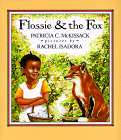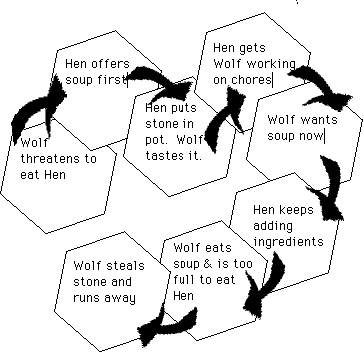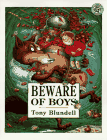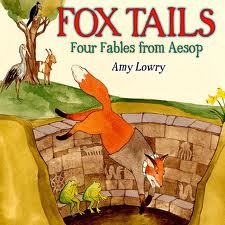Fools & Tricksters

This is an excerpt from Open Books: Literature in the Curriculum by Carol Otis Hurst. Linworth, 1999. ISBN 0938865773. Order Online.
Comments:
Folk literature from around the world is replete with trickster tales. Some like the Anansi tales of Africa and the Caribbean, and their American derivatives, the Br'er Rabbit stories, have continuing characters both as trickers and "trickees". Many modern composed stories also revolve around a trickster and/or a fool. Often these stories are funny and sometimes they are subtle. Analyzing and categorizing these stories can be a valuable activity involving many disciplines
Picture Book for Starters:

Patricia McKissack& Rachel Isadora's Flossie and the Fox (Dial, 1986 ISBN 0803702507. Hardcover.) is a funny story in which a frequent victim, an innocent, fools the stereotyped trickster, the fox.
Flossie's on her way to deliver a basket of eggs when a fox stops her on the road and wants those eggs. Flossie claims not to believe that he is a fox and, as he tries to prove himself, she gets nearer and nearer her neighbor's house. When close enough, his hounds know a fox when they see one.
Activities:
Language Arts:
Reading: Put out as many picture book trickster and fool tales as possible. Suggest that children read them; read aloud as many as you find appealing. List the books on a chart and check off the ones that have been read by at least one person in the classroom.Classifying: Elicit from the children various elements in the books they have read. Some possibilities:
- One character doesn't have all the information
- One character isn't listening
- One character is disguised
- One character misunderstands a statement
- One character isn't being logical
- One character isn't very smart
Many trickster tales are folk tales. Usually the author or editor tells you somehow that a story is a folk tale and not an original tale written by the author. Sometimes, on the title page it will say, "retold by" instead of just "by". Other times the book flap or author's note tells the source of the tale. Sort the books the class has read for this theme according to whether or not it's a folk tale.
Writing: Divide a bulletin board with sections for each of the elements from the previous activity. Suggest that children write about or draw an incident from one of the tales that fits a category and place it in the proper section.
Asking Questions: Make large pictures of characters from the tales on poster board, cutting a child-sized face hole in the picture. Play a game where a child holds up a poster in front of him or herself without seeing the figure on the poster. The child then asks questions to identify him or herself such as: Am I an animal? Am I in a Br'er Rabbit story? Am I bigger than a rabbit? etc.
Making Comparisons: During discussion circle time tell the students about a trick that was played on you or that you played on someone else. Suggest that they share similar stories about themselves.
Outlining: After sharing one of the picture books, make a flow chart with the class such as the following.

Book List:
Fiction:
Aardema, Verna. Anansi Finds a Fool (Dial,1992 ISBN 0803711646 Hardcover.)
Anansi searches for a partner more foolish than he who will do the greatest share of the work. Bonsu agrees to do all the work if Anansi will take all the tiredness that results. Anansi, insisting that the fatigue is the worst part, insists on doing all the work instead. The watercolor illustrations show the patterns and textures of this society of Ghana.
Aardema, Verna. Bimwili & the Zimwi (Dial,1985, ISBN 0140546081. Paperback.)
Bimwili, the youngest sister, runs back to the seashore to retrieve her shell and is captured by the Zimwi, an evil troll-like creature. She forced to sing from inside his drum as he travels from village to village. When she sings in her own village, her mother recognizes her voice and demands her freedom. The illustrations are watercolor with colored pencil

Blundell, Tony. Beware of Boys (Greenwillow,1991, ISBN 0688109241. Paperback.)
A small boy wanders into the woods and is captured by a hungry wolf. The boy suggests a series of recipes that the wolf might use to cook him. In doing so, the boy gets the better of the wolf in this clever story. The recipes involve a great deal of measurement and the plot will remind some of Stone Soup.
Coplans, Peta. Cat and Dog (Viking,1996 ISBN 0670867667. Hardcover.)
A dog tricks a cat into calling out numbers and eats that many things from the cat's picnic.
Farmer, Nancy. Runnery Granary (Greenwillow,1996 ISBN 0688141870. Hardcover.)
Finely detailed watercolors illustrate this tale of a granary owner who finds some grain missing. First suspecting weevils, then rats, she learns that the culprits are gnomes. Old Granny knows how to get rid of them and the granary is free of the pests. The names of the granary family: Mrs. Runnery, Hillary Runnery, Valery Runnery and Granny Runnery are fun to say and to add possible family members.
French, Fiona. Anancy and Mr. Dry-Bone (Little, 1991 ISBN 0316292982. Out of Print)
This is a Caribbean variant of the Anansi tales of Africa. In it, Anancy, the spider, is hired to make Miss Louise laugh, a task, which pits him against wealthy Mr. Dry-Bone. Stylized paintings in bold colors play against black silhouettes and geometric forms.
Lobel, Arnold. Treeful of Pigs (Greenwillow,1979,0688841775. Library Binding.)
A very lazy farmer spends his time in bed instead of helping his wife take care of their herd of pigs. His poor wife tries lots of tricks to get the farmer to help her. Finally, she finds a trick that gets him doing her work as well as his. Author Info.
Palatini, Margie. Piggie Pie! (Clarion/Houghton,1995 ISBN 0395716918. Library Binding, Paperback, Cassette.)
Subtle it isn't, but it is funny. A witch has all the ingredients for the piggie pie she craves except eight pigs. After consulting the yellow pages, she arrives at Old MacDonald's farm, announcing her arrival with skywriting. The pigs disguise themselves well enough to fool the witch but not the reader.
Root, Phyllis. Aunt Nancy and Old Man Trouble (Candlewick,1996 ISBN 1564023478. Library Binding, Paperback.)
Aunt Nancy knew she was in for a bad day when the spring dried up and she lost her lucky nickel. Sure enough, it wasn't long before Old Man Trouble himself showed up. Aunt Nancy soon gets the best of him, however, by making the best of every bad thing he does. This is an engaging story told in the vernacular.
Ross, Tony. Stone Soup (Puffin, 1990 ISBN 0803708904. Paperback.)
Ross puts a red hen in as the cook in this slightly cockeyed version of the old favorite. His villain is the big bad wolf and there's a double con game afoot.
Sierra, Judy. Wiley and the Hairy Man (Lodestar,1996 ISBN 0525674772. Hardcover.)
This tale has been done before as a picture book by Molly Bang but this new version of the Alabama folk tale is equally good. The idea of the innocent boy and his mama outwitting the frightening Hairy Man is fun and scary
Soto, Gary. Chato's Kitchen (Putnam,1995 ISBN 0399226583.Library Binding, Paperback.)
In this allegory, Chato the cat, asks some mice over for dinner. He expects, of course, to eat them and he and his friend prepare some delicious Mexican food to go with the main course. When the mice arrive, they bring with them their friend, a dog, and the feast turns out to be a meatless one. The fun in this book comes from the sly characterization of the cats, mice and dog as barrio habitues and there is wordplay with many of the Mexican phrases.
Spooner, Michael. Old Meshikee and the Little Crabs (Holt,1996 ISBN 0805034870. Library Binding.)
This folktale from the Ojibwe is useful because of its strong kinship with Br'er Rabbit and the Briar Patch.
Strete, Craig Kee and Michelle Netten Chacon. How the Indians Bought the Farm (Greenwillow,1996 ISBN 0688141307. Hardcover.)
This is a funny book about an Indian chief and his wife forced out of their home by a government man. Ordered to live on a farm and raise sheep, pigs and cows or lose that, too, they use their only resource - the love and communication with wildlife to trick the government men.
Van Allsburg, Chris. Widow's Broom (Houghton, 1992 ISBN 0395640512. Library Binding.)
This is more subtle than most of the trickster tales. When a broom loses its flying power, it is left behind at Widow Minna Shaw's home. Gradually, the Widow discovers that the broom can be taught to do many things including playing the piano although what it does best and prefers to do is sweep. The widow is delighted but her neighbor, Mr. Spivey reacts with fear and loathing, considering it to be the devil's tool. Eventually, he comes with some other neighbors to demand the Widow's broom. Regretfully, she tells them it is in the closet and that it is sleeping. Carefully they remove the broom, tie it to a stake and burn it. Later, the ghost of the broom is seen coming closer and closer to the Spivey's house. It's not until the Spivey's have moved away that we discover the trick the widow has played so that she and her broom can live in peace
Wooldridge, Connie Nordhielm. Wicked Jack (Holiday House,1995 ISBN 082341101X. Library Binding, Paperback.)
This retelling of a Richard Chase tale is done in a backwoods rolicking manner. It tells of a man who outwits the Devil and ends up so mean neither Heaven or Hell will have him. The Devil gives him a coal to start his own Hell which explains what others call marsh gas.
Wyllie, Stephen. Flea in the Ear (Dutton,1995, ISBN 0525456481. Hardcover.)
This is a story of an out-foxed fox. First the fox tricks the dog into leaving his post as chicken guard. Then the dog turns the tables. It's a plot easily absorbed and enjoyed by the very young.
Later Additions Since "Open Books" Was Printed
 Fox Tails: Four Fables from Aesop by Amy Lowry. (2012, Holiday House. ISBN 9780823424009. Order Info.) Picture Book. 32 pages. Gr K-4.
Fox Tails: Four Fables from Aesop by Amy Lowry. (2012, Holiday House. ISBN 9780823424009. Order Info.) Picture Book. 32 pages. Gr K-4.
Four fables, all featuring a fox, have been combined into one story. "The Fox and the Grapes" (of sour grapes fame), "The Fox and the Crow," "The Fox and the Goat," and "The Fox and the Stork" all star a trickster fox, but, in the end, the tables are turned. Lowry has illustrated the story with gentle, clean drawings which reward closer inspection with hidden details. This is a subtly humorous, satisfying read.
Related Areas of Carol Hurst's Children's Literature Site
- More about Open Books by Carol Hurst including other sample chapters.
- Other Books by Carol Hurst.
- Beware of Boys by Tony Blundell. Book review.
- Food and Stone Soup, Featured Subject. Activities, related books and links.
- Other Subjects and Themes in Children's Literature.
Related Areas on the Internet
- Peter Michaels' Trickster Page. This very complete list of resources is intended for adults but with a little guidance from an adult students can find many wonderful materials.
Return to Newsletter Table of Contents
This article is from the November1999 newsletter.
Advertisement:
Advertisement:
Advertisement:

